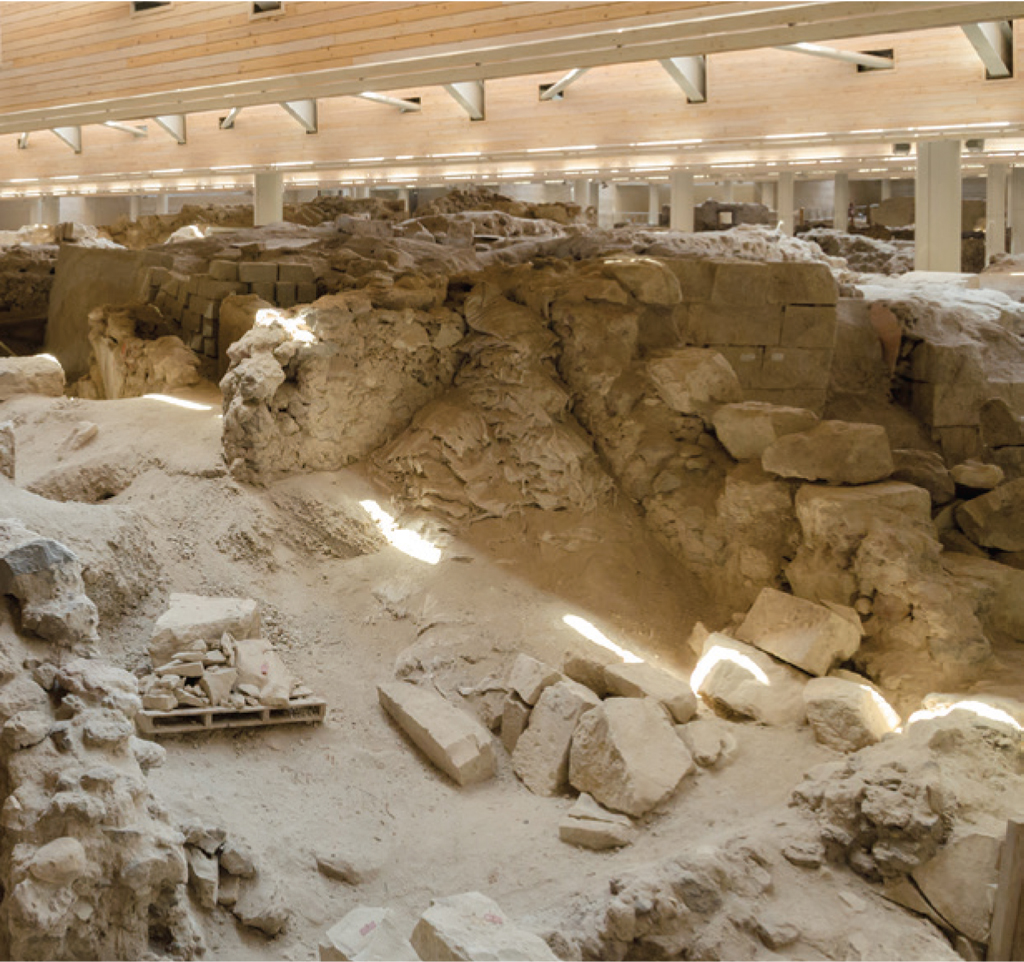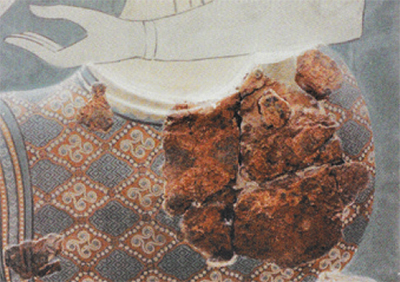Bronze Age Clothing in Minoan Crete was multicolored and made from intricately woven textiles. Until now, our only evidence related to the colors in the textiles came from the study of costume in wall paintings. Fortunately, recent research has revealed that several different dyes were produced in Minoan Crete.
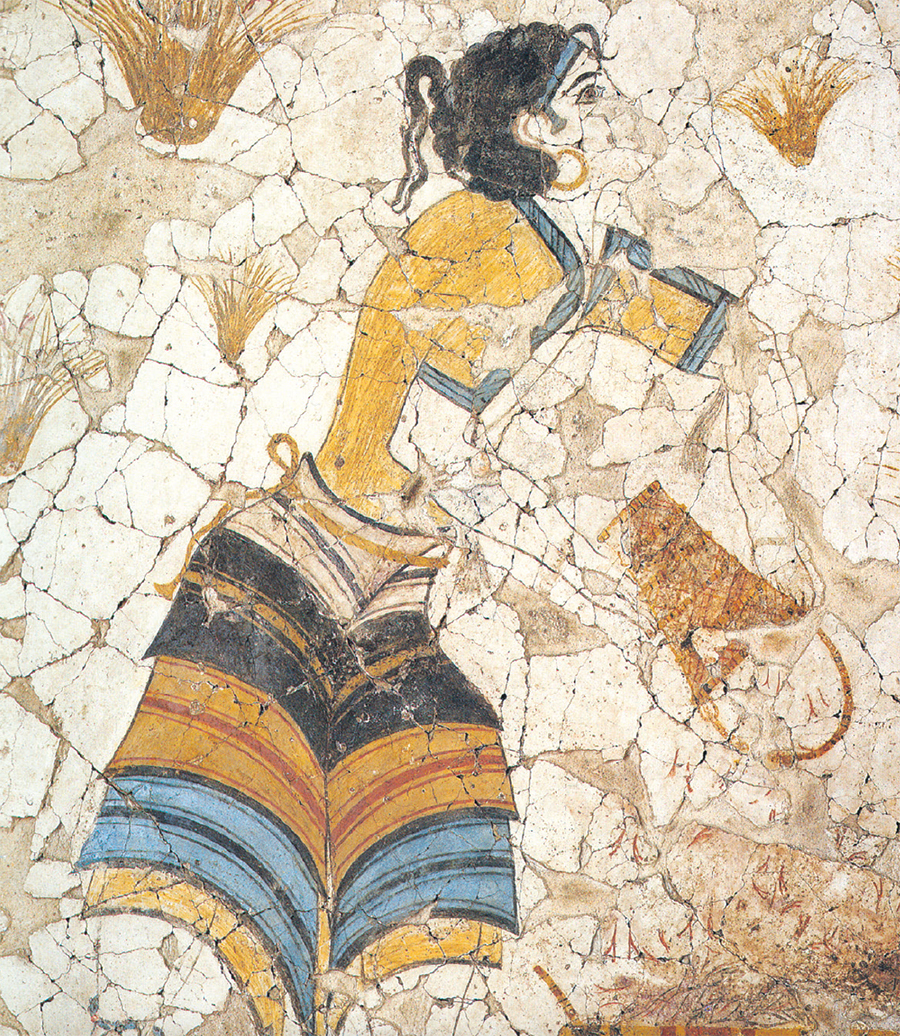
Clothing is depicted in frescoes and other art forms from various Middle to Late Bronze Age Aegean sites (ca. 1700–1400 BCE). Many of these images—such as those on the tiny surface of seals—fail to convey the strikingly colorful nature of Minoan garments. And the representation of a blue bodice is not sufficient evidence to conclude that Minoans wore indigo-dyed, blue, woolen clothing. To identify the dyestuffs used during this period, we conducted scientific analysis of the pottery from a dye workshop at Alatzomouri-Pefka in Crete.
Minoan Clothing
In Minoan art, men and women are shown dressed in various garments that involve a range of simple and complex designs. This clothing incorporates a variety of colors, many of which must have been derived from natural dyestuffs. Some organic dyes, though none that we found, also require the use of a mordant, an inorganic oxide that creates a chemical bond between the fiber and the dye. The choice of fiber also played an important role in the use of color. Linen fabrics are widely attested as used in Bronze Age Crete, but experiments have shown that linen is not easily dyed. On the other hand, woolen fibers accept dyes well and, therefore, are more likely to have been used as material for the creation of brightly colored clothing.
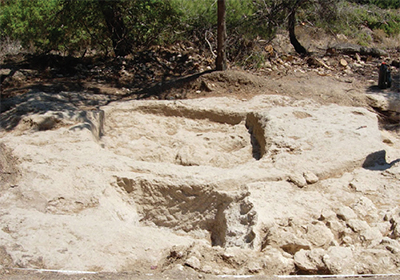
Many of the vibrant hues found on Minoan clothing are executed as patterns. The warp-weighted loom is well suited for the creation of such designs, and its use by the Minoans is documented by the presence of caches of loom weights from several sites. These weights—the only inorganic part of the loom—provide evidence for the widespread use of this loom throughout Minoan Crete. Dye workshops, however, are much rarer finds.
The Workshop at Alatzomouri-Pefka
The archaeological site of Alatzomouri-Pefka, dating to Middle Minoan IIB (ca. 1750–1700 BCE), is located along the rocky, northern Cretan coastline, west of the village of Pacheia Ammos. Several settlements dotted this region during the Bronze Age. Although this small site may have been associated with Gournia, the largest nearby settlement, it is situated well beyond the area that would today be considered the suburbs of Gournia. The distant location may be related to the sometimes odiferous nature of processing dyes.
Features found at the site provide evidence for a dye workshop. Dye production required a large amount of water. Alatzomouri-Pefka has a deep well, rock-cut vats, and basins. The well is in the northern area, surrounded by the largest rectangular basin on site. A shallow, circular, rock-cut vat is nearby as is a row of seven rectangular basins. It is not surprising that the site is composed of several artificial cavities in the bedrock because multiple separate dye baths were probably created and used simultaneously. Nearby crumbling stone walls were probably not associated with a permanent house, but may have been part of a shelter for the craftsmen and craftswomen who worked on site.
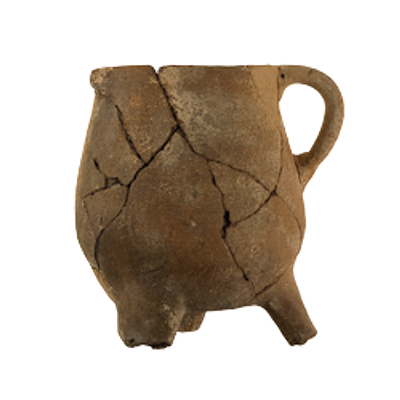
Water is integral to the creation and use of dyes—to wash wool, create a dye bath, and to soak fibers—all of which could occur in the rockcut vats. Additionally, many tripod vessels from the site were burned on the outside of their bases, suggesting that heat was necessary for the preparation of at least one dye. Several crushed murex shells from the site indicate the possible manufacture of purple dye, which could be used for embroidery, like that seen on the sleeve of the Seated Goddess from Thera (see image on page 25 of this issue, in the bottom right corner). Many pigment sources, like murex, must be crushed and heated during production, and evidence for these activities is supplied by the burned tripods and also by the many recovered stone tools that may have been used for these types of tasks.
Methodology for Dye Identification
Ceramic tripods, as well as other clay vessels from the site, were certainly involved in the processing of the raw material for dyestuffs. The porous nature of pottery allows for the absorption of a tiny amount of the ancient contents into the walls of the vessel. The residues from these contents may be extracted and then subjected to gas-chromatography mass-spectrometry (GC-MS), an analysis method that identifies the chemical composition of organic compounds.
Samples were extracted from vessel walls by heating pottery submersed in solvents at the INSTAP Study Center for East Crete and then taken to the Brandeis University Department of Chemistry for GC-MS analysis under the direction of Dr. Andrew Koh. The procedure took 28 minutes to analyze each residue. In order to verify that no contaminants existed from previous runs, solvent blanks were used intermittently. This
process was successfully used to discover the contents of the clay vessels from Alatzomouri-Pefka.
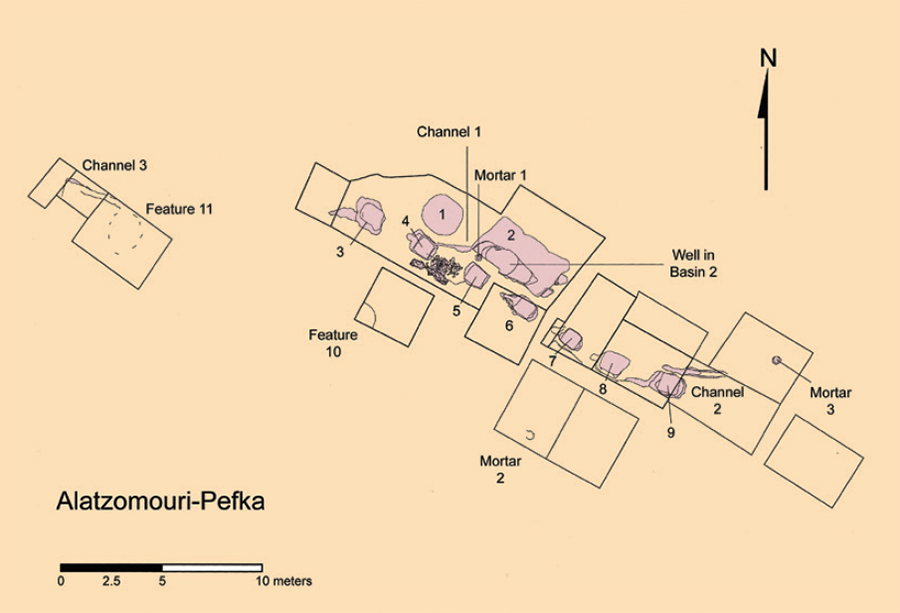
Identifying Residues in Pottery
- Gas-chromatography mass-spectrometry (GCMS) is a non-destructive method of analysis for identifying the degraded residues of pottery.
- Gas-chromatography is a way of separating the molecular compounds present in a sample by firing it through a column of non-reactive gas (typically helium, hydrogen, and/or nitrogen).
- Different molecules pass through the column at different speeds, and the mass-spectrometer is able to then distinguish the compounds present in the sample based on the speed of each one.
- The results are presented in a graph, and the highest spikes indicate the most prominent compounds in the sample. In our study, a total of 21 objects were selected for analysis. Two samples were taken from each vessel, and 42 samples were analyzed.
Dyes from Shells and Plants
As initially indicated by the presence of Hexaplex trunculus shells (a species of murex) at the site, “royal purple” may have been one of the dyes manufactured at the workshop. Ancient writers, including Aristotle and Pliny, describe in detail the creation of purple dye from the mollusk. First, the creature is crushed and a tiny gland is extracted. The secretion from this gland is oxidized, added to water, and heated to create a brilliant purple dye. Residues from murex purple dye were indeed discovered in several clay vessels from the site, including a large decorated pot.
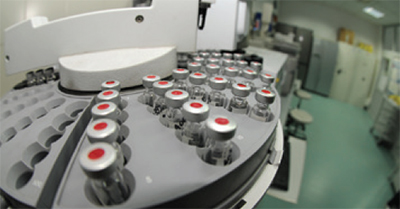
Madder is a source of many red dyes today and has been identified in several clay vessels that we examined. The plant that renders this beautiful dye, Rubia tinctorum, grows all over the world, including Greece. Textual evidence exists for the use of madder in dye-making as early as Classical times, but it was apparently used before then in Crete. The plant’s roots are severed and mashed, then heated to produce the dye. The abundance of the plant, the brilliance and beauty of the resulting color, and the resistance of this dye to fading led to the widespread popularity of the dye in the ancient world.
Evidence for the use of a lovely yellow dye was also recovered from this workshop. Reseda lutiola, another dye-producing plant, is commonly referred to as weld. Like madder, the plant material must be processed to create the pigment: all parts of the plant except the roots are chopped and muddled, then heated in water. Unlike most yellow dyes, this plant creates a deep golden color that does not fade easily. Residue from weld was discovered in one vessel that also contained murex purple, but whether they were mixed together or used independently is currently unknown.
Other Materials Used in Dye-Making
Lanolin, the oil produced by sheep, clings to wool fibers when they are removed from the animal. The wool is cleaned (scoured) to remove the oil from the fibers because if the lanolin is not removed, the wool will not accept a water-based dye. Water is used for the scouring process and the separated oil will then float on top of it. This substance can then be skimmed off the surface and reused for other purposes, like treating leather. Lanolin residue was discovered inside pottery found at the site.
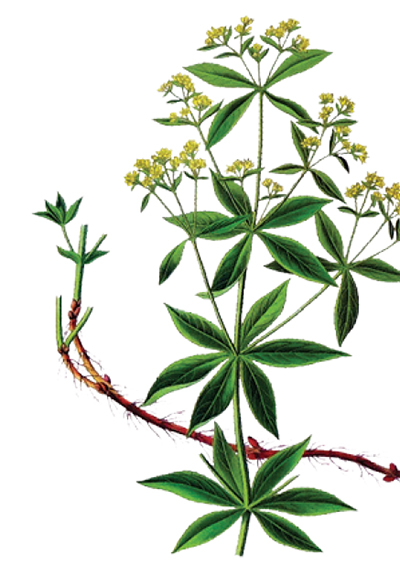
Urine was also detected in one of the vessels from Alatzomouri-Pefka. The substance was discovered in the right rear vase of a triple vessel that is composed of three different yet connected containers. Through a hole, the two rear vessels connect to the front spouted pot; the substances in the two back jars come together before the mixture is poured out of the front, spouted container. Evidence of murex dye was recovered from the spouted jar. Pliny describes mixing murex and urine to create an attractive pale purple color (rather than using murex alone), but he does not explain how or in what proportions the ingredients should be mixed. Unfortunately, we cannot learn this information through residue analysis.
Evidence for Minoan Dyes in Frescoes
Evidence for all three of the dyes discovered at Alatzomouri-Pefka survives in wall paintings from the same period. In the frescoes from Akrotiri, Thera (once called Santorini), images of young women dressed in elaborate Minoan clothing—with red, yellow, and purple details —are preserved. Although the striking red and yellow pigments survive well, the purple has largely faded so that all that remains of this pigment is a ghost, a gray stain in raking light. For this reason, both photographs and watercolor reproductions of the frescoes are provided here to show the nearly invisible purple details on clothing.
In the frescoes from Xeste 3 at Akrotiri, each figure is named for a distinguishing trait: the Necklace Swinger holds a necklace of red beads in one hand, the Veiled Girl wears a full-length yellow veil that is dotted with red beads or embroidery, and the Seated Goddess sits in front of a heraldic griffin and accepts an offering of crocus stamens from a blue monkey. The clothing of each of these figures depicts further evidence for Minoan textiles that were colored with dyes like those discovered at Alatzomouri-Pefka.
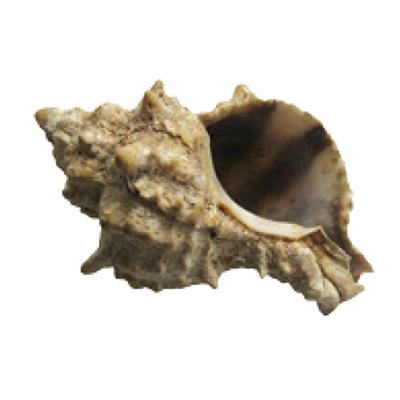
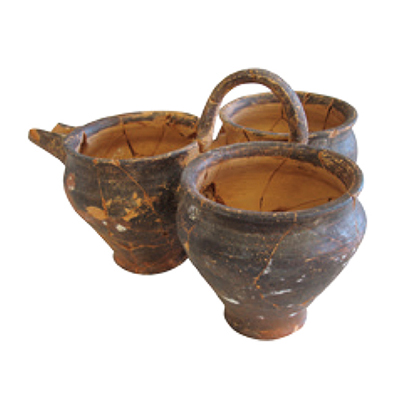
The Necklace Swinger wears a multi-layered flounced skirt and an open bodice, both of which appear standard in depictions of women from Xeste 3. She is adorned with several types of elaborate jewelry and wears a sash or ribbon in her hair. Both the sash and bodice feature the vibrant colors that are positively identified as dyes like those that came from the workshop on Crete. The sash, yellow with red borders, could have been dyed using weld and madder. The same two colors are found on the band that runs down the arm of the gauzy open bodice.
Although the woman’s silhouette is seen through the sheer material, purple crocuses with red stamens dot the fabric of her bodice. These decorative motifs may have been embroidered on the clothing, perhaps with woolen thread.
A similar color scheme appears on the Veiled Girl, who wears a white bodice with thick blue bands and thin red bands at the sleeves and shoulders. Additional bright red bands also decorate the back of the garment and, in the otherwise blank space, purple crocuses are painted. If the garment in the fresco actually existed, the bands and crocuses may have also been woolen embroidery, as was the case on the Necklace Swinger’s bodice. Additionally, the yellow veil that nearly covers the young girl may be the largest yellow textile preserved in Aegean fresco.
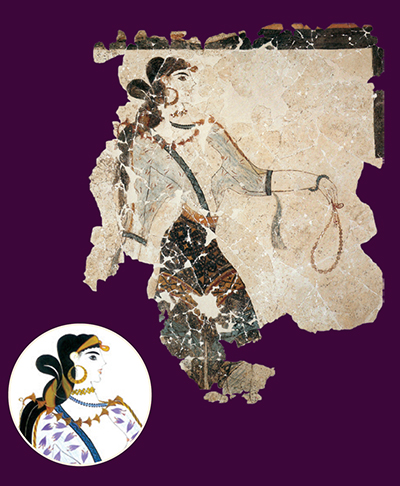
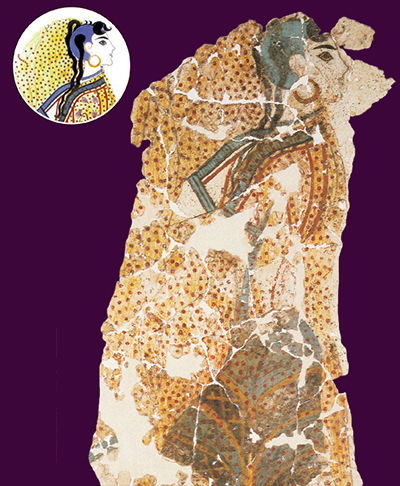
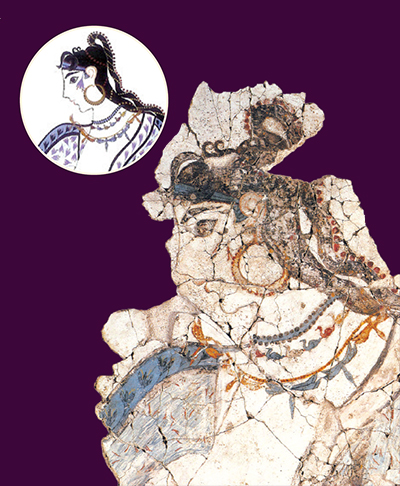
Finally, the Seated Goddess features even more crocus iconography than the Veiled Girl or the Necklace Swinger. On an open white bodice, purple crocuses with red stamens dot the fabric. Black crocuses are painted on the blue bands that line her shoulders and arms. Another band of fabric across her knees features a repeating pattern of abstracted black crocuses. A purple crocus, again complete with red stamens, is either tattooed on her cheek or rests against her cheek with the stem tucked behind her ear. Although the color represented most often on the goddess figure is purple, small, circular, red and yellow objects—perhaps beads or small pompom-like decorations—and red tassels ornament the bottom of her sleeves.
The only two colors represented on the clothing in these frescoes that are not identified as dyes that may have come from Alatzomouri-Pefka are black and blue. Black dye may have been produced during the Bronze Age by boiling pods from the carob tree. Unfortunately, no chemical evidence has been found for the raw material used to create blue dyes for the blue clothing seen in frescoes from the Minoan period.
Residue analysis has verified the production of red, yellow, and purple dyes in Crete, as well as the use of wool in Bronze Age textiles. The relationship between representations of textiles in art and the reality of analyzed residues presents great opportunities for future research in both archaeology and art history. As this study shows, portions of the information presented in Minoan wall paintings illustrate a clear, demonstrable tie to the material reality of the Bronze Age Aegean.
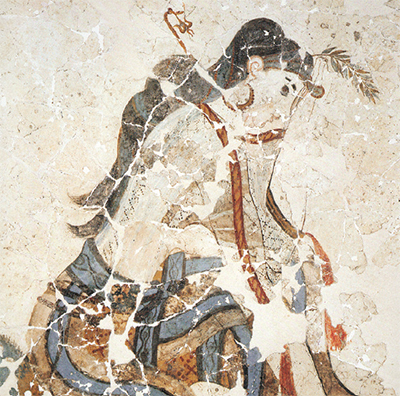
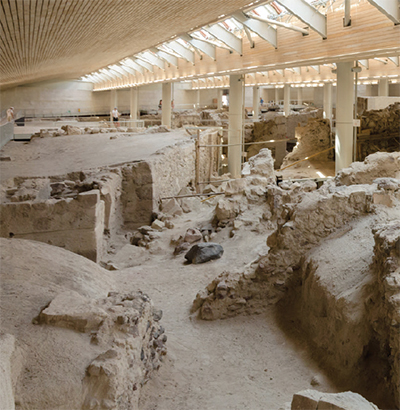
The Research Team
After the site of Alatzomouri-Pefka was excavated, a research team was organized to investigate traces of organic residues in the pottery. The project had three co-directors: Vili Apostolakou, Director of the excavations and Director Emerita of the 24th Ephorate of Prehistoric and Classical Antiquities in East Crete; Dr. Thomas M. Brogan, Director of the INSTAP Study Center for East Crete; and Prof. Philip P. Betancourt, Professor at Temple University, Philadelphia and Consulting Scholar in the Mediterranean Section at the Penn Museum.
Other members of the team included: Kathy Hall, Senior Conservator at the INSTAP Study Center for East Crete; Prof. Andrew Koh at Brandeis University; Dr. Marie Nicole Pareja, Managing Editor of the Corpus of Aegean Wall Paintings Project at INSTAP and Consulting Scholar in the Mediterranean Section at the Penn Museum; and Alison M. Crandall, student at Brandeis University.
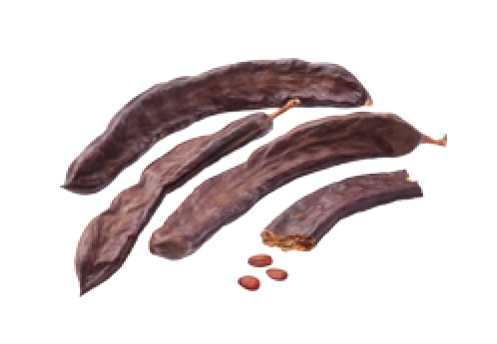
Working under a permit issued by the Greek government, samples from sherds were removed using non destructive means under the supervision of Kathy Hall. The INSTAP Study Center for East Crete is the headquarters for archaeological scholarship in Crete, whose U.S. affiliation is the Penn Museum. Samples were analyzed at the Brandeis University Department of Chemistry in Waltham, Massachusetts.
For Further Reading
Betancourt, P.P., V. Apostolakou, and T.M. Brogan. “The Workshop for Making Dyes at Pefka, Crete,” in KOSMOS: Jewelry, Adornment and Textiles in the Aegean Bronze Age, edited by M.-L. Nosch and R. Laffineur, pp. 183-186. Leuven and Liège, 2012.
Doumas, C. The Wall Paintings of Thera. Athens and London: The Thera Foundation, 1992.
Jones, B.R. Ariadne’s Threads: The Construction and Significance of Clothes in the Aegean Bronze Age. Leuven: Peeters, 2015.
Koh, A.J., P.P. Betancourt, M.N. Pareja, T.M. Brogan, and V. Apostolakou. 2016. “Organic Residue Analysis of Pottery from the Dye Workshop at Alatsomouri-Pefka, Crete,” Journal of Archaeological Science: Reports 7 (2016): 536-538.
Shaw, M.C., and A.P. Chapin, eds. Woven Threads: Patterned Textiles of the Aegean Bronze Age, Havertown: Oxbow Books, 2015.
